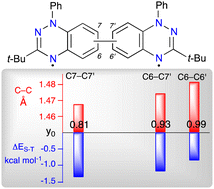Bi-Blatter diradicals: convenient access to regioisomers with tunable electronic and magnetic properties†
Abstract
A general strategy for synthesis of bi-Blatter diradicals with tailored properties has been developed and illustrated with three prototypical diradicals. Thus, three bi-Blatter diradicals connected directly through the spin-rich C(6) and C(7) positions were obtained using azaphilic addition of PhLi to bi-benzo[e][1,2,4]triazines and characterized by spectroscopic, electrochemical and structural methods. These results were compared to those of the analogous monoradical. The singlet–triplet energy gaps, ΔES–T, were determined for the diradicals with VT EPR spectroscopic methods in polystyrene solid solutions. The increasing singlet stability in the series (ΔES–T = −0.81 to −1.33 kcal mol−1) correlates with a decreasing y index (0.99–0.81), a decreasing C–C distance (1.481–1.467 Å) between the heterocyclic units, and with an increasing spin density at the connecting sites (0.04 and 0.07). All three diradicals exhibit high thermal stability (up to 270 °C) and moderate UV-vis photostability in air (t1/2 = 25–35 h) in 1 × 10−4 M solutions in CH2Cl2. The modular synthesis of the diradical allows for control of their properties by a judicious choice of substituents at the C(3) and N(1) positions.



 Please wait while we load your content...
Please wait while we load your content...